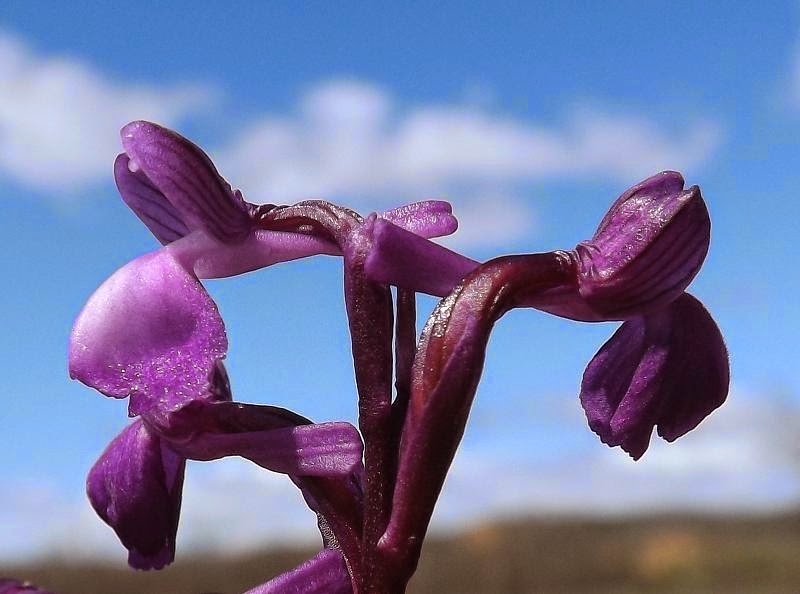
Just another orchid from the Cantabrian Mountains: the Anacamptis champagneuxii, member of the section Moriones.
The Anacamptis champagneuxii is a rare and purple colored orchid from the western Mediterranean, also present in the strip of wild nature directly adjacent to the Southern Cantabrian Mountains. Until about 10 years ago the genus Anacamptis counted only one member, namely the pyramidal orchid (Anacamptis pyramidalis). However, due to the strong rise of the genetic research the former orchid classifications have been shaken up quiet a bit. Many orchids which traditionally were counted to the genus Orchis were found to have much more in common with the Anacamptis pyramidalis than was ever suspected. The research of Richard Bateman and co-workers in 2003 led to a new classification based on phylogenetics and other aspects. As always in science not all researchers agreed with the changes, but today it seems to be the most widely accepted classification. However, because of this relatively recent change and some resistance against the new name , it is possible to find this orchid in the literature as the Orchis champagneuxii. The genus Anacamptis is divided into sections and the Anacamptis champagneuxii belongs to the section Moriones which also include the green winged orchid (Anacamptis morio) and the Anacamptis picta, which are all present in the Cantabrian Mountains.The species name champagneuxii is in honor of the French botanist Champagneux (1774-1845).
The Anacamptis champagneuxii is especially similar to the Anacamptis picta, which is also known as a subspecies of the green winged orchid (Anacamptis morio subs picta) and therefore it can be hard to tell them apart and therefore I first want to enumerate the most striking differences between both orchids.
The Anacamptis champagneuxii is especially similar to the Anacamptis picta, which is also known as a subspecies of the green winged orchid (Anacamptis morio subs picta) and therefore it can be hard to tell them apart and therefore I first want to enumerate the most striking differences between both orchids.
- The central part of the lip of the A. champagneuxii is completely white or pink (perhaps with very faint spots), instead the lip is speckled.
- The side lobes of the lip of the A. champagneuxii arealmost completely folded back, much more than the lip of the A.picta, which even can be wide spread.
- The spur of the A.champagneuxii is longer in proportion and at the end more flattened.
- The spike of the A.champagneuxii is shorter, thinner and with fewer flowers.
- The A.champagneuxii grows very often in striking compact groups, which is due to its vegetative propagation.
- The A.champagneuxii seems to have three tubers while the A picta has only 2 tubers, but obviously we are not going to dig up, so in practice its not a very useful feature.

READ FURTHER AND ENJOY THE PHOTOS.
To the left the Anacamptis picta and to the right the Anacamptis champagneuxii. On this A. picta the lobes are folded back but not so much. The most notorious differences are the size, amount of flowers and the speckles on the lip of the A. picta.
The lobes of the lip of the Anacamptis champagneuxii are strongly folded back, which is one of characteristics which differentiates it from the A. picta.
The A. champagneuxii is smaller than the closely related A. picta. It´s a slender orchid with a maximum height of about 30 centimeters and with a thin spike which usually has no more than 6 flowers, although some specimens can have 8 flowers or more.
The upper sepals and petals form together a helmet and have dark purple (sometimes green) stripes. because of this "hat" the orchid of the section Moriones are called "jesters" in many languages.
The spur is very flat at its end.
The general appearance of the spike is very loose with only a few flowers far apart.
The bract is dark purple (darker than the flower) and shorter than the ovary.
The central part of the lip is completely white (or pink) and without the spots of the other Moriones.
One of those typical small groups formed by vegetative expansion of the roots. If you see such a compact group of small purple orchids with distinctive white spots in the centre: bingo, a great discovery.
Detail of the gynostemium or column, which is the structure where the reproductive organs are situated.
This photo shows several of its distinctive features: the thin spike, lobes of the lip folded backwards and the relatively long and flattened spurs.
Bottom-side of the flower. Here, the folded-back lobes of the lip and the fact that the spur is an extension of the lip is clearly visible.
The ovaries are dark purple and appear from a distance even black. Also are they twisted because the orchid flowers rotate 180 degrees, so that the lip becomes below.
The rosettes are light green and the bottom of the stem has a number of sheathing leaves. Higher up the stem soon colours purple.
Detail of the lip or labellum.
Especially on this and the next picture is the twisting of the ovary good visible
After reading so many distinctive features this an Anacamptis champagneuxii or not?

















Hallo Marius
ReplyDeleteSchitterend wat een mooie bloem. Dat is genieten, om zoveel moois in de natuur te zien.
Groeten Bets
Hallo Bets, genieten is het zeker.
ReplyDeleteGroetjes, Marius
Hey there! I’m at work browsing your blog from my new iphone 3gs! Just wanted to say I love reading through your blog and look forward to all your posts! Keep up the outstanding work!
ReplyDelete야설
오피
마사지블루
건전마사지
온라인카지노